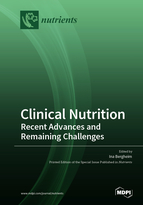Clinical Nutrition: Recent Advances and Remaining Challenges
A special issue of Nutrients (ISSN 2072-6643). This special issue belongs to the section "Clinical Nutrition".
Deadline for manuscript submissions: closed (30 June 2021) | Viewed by 198480
Special Issue Editor
Interests: intestinal barrier; nutrition; bacterial endotoxin; alcoholic liver disease; non-alcoholic fatty liver disease
Special Issues, Collections and Topics in MDPI journals
Special Issue Information
Dear Colleagues,
Nutrition, often along with physical activity, is by now acknowledged as a cornerstone in the prevention and even more so the treatment of many diseases. Indeed, food and nutritional intake by now often thought to be the main source of wellbeing sometimes over- but also underestimating the impact of nutritional intake, dietary pattern and food-derived natural compounds in their impact on human health. In this Special Issue entitled `Clinical Nutrition: Recent Advances and Remaining Challenges´ we will provide a broad overview and summary on recent findings in various fields of clinical nutrition with special focus on chronic and degenerative diseases like metabolic diseases, cancers, neurodegenerative diseases, inflammatory bowel diseases, sarcopenia but also malnutrition in elderly, infants and children. The reviews presented should aim to provide an overview on recent developments in the different field of clinical nutrition and will be of special interest to health professionals including nurses, dietitians, physicians, and other practitioners as well as basic scientists working in different settings of clinical nutrition.
Prof. Dr. Ina Bergheim
Guest Editor
Manuscript Submission Information
Manuscripts should be submitted online at www.mdpi.com by registering and logging in to this website. Once you are registered, click here to go to the submission form. Manuscripts can be submitted until the deadline. All submissions that pass pre-check are peer-reviewed. Accepted papers will be published continuously in the journal (as soon as accepted) and will be listed together on the special issue website. Research articles, review articles as well as short communications are invited. For planned papers, a title and short abstract (about 100 words) can be sent to the Editorial Office for announcement on this website.
Submitted manuscripts should not have been published previously, nor be under consideration for publication elsewhere (except conference proceedings papers). All manuscripts are thoroughly refereed through a single-blind peer-review process. A guide for authors and other relevant information for submission of manuscripts is available on the Instructions for Authors page. Nutrients is an international peer-reviewed open access semimonthly journal published by MDPI.
Please visit the Instructions for Authors page before submitting a manuscript. The Article Processing Charge (APC) for publication in this open access journal is 2900 CHF (Swiss Francs). Submitted papers should be well formatted and use good English. Authors may use MDPI's English editing service prior to publication or during author revisions.
Keywords
- Clinical Nutrition
- Chronic degenerative diseases
- Therapy
- Prevention
- Metabolic disease
- Inflammatory bowel disease
- Sarcopenia
- Neurodegenerative diseases
- Malnutrition
- Cancer







